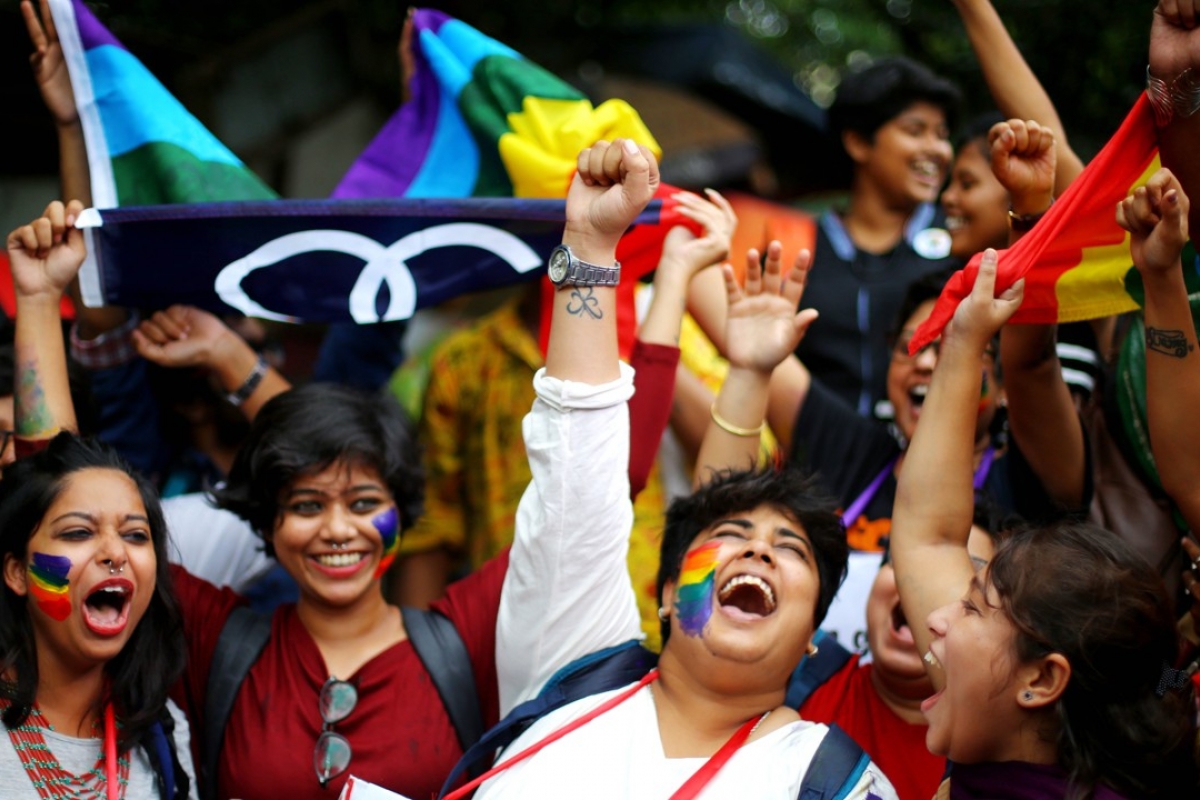In 1924, Henry Gerber, a German immigrant, founded in Chicago the Society for Human Rights, the first documented gay rights organization in the United States. During his U.S. Army service in World War I, Gerber was inspired to create his organization by the Scientific-Humanitarian Committee, a “homosexual emancipation” group in Germany.
Gerber’s small group published a few issues of its newsletter “Friendship and Freedom,” the country’s first gay-interest newsletter. Police raids caused the group to disband in 1925—but 90 years later, the U.S. government designated Gerber’s Chicago house a National Historic Landmark.
The gay rights movement stagnated for the next few decades, though LGBT individuals around the world did come into the spotlight a few times.
For example, English poet and author Radclyffe Hall stirred up controversy in 1928 when she published her lesbian-themed novel, The Well of Loneliness. And during World War II, the Nazis held homosexual men in concentration camps, branding them with the infamous pink triangle badge, which was also given to sexual predators.
In 1950, Harry Hay founded the Mattachine Foundation, one of the first gay rights group in USA. The Los Angeles organization coined the term “homophile,” which was considered less clinical and focused on sexual activity than “homosexual.”
The gay rights movement saw some early progress in the 1960s. In 1961, Illinois became the first state to do away with its anti-sodomy laws, effectively decriminalizing homosexuality, and a local TV station in California aired the first documentary about homosexuality, called The Rejected.
The Stonewall Inn
A few years later, in 1969, a now-famous event catalyzed the gay rights movement: The Stonewall Riots.
The clandestine gay club Stonewall Inn was an institution in Greenwich Village NY, because it was large, cheap, allowed dancing and welcomed drag queens and homeless youths.
But in the early hours of June 28, 1969, New York City police raided the Stonewall Inn. Fed up with years of police harassment, patrons and neighbourhood residents began throwing objects at police as they loaded the arrested into police vans. The scene eventually exploded into a full-blown riot, with subsequent protests that lasted for five more days.
Christopher Street Liberation Day
Shortly after the Stonewall uprising, members of the Mattachine Society split off to form the Gay Liberation Front, a radical group that launched public demonstrations, protests, and confrontations with political officials.
In 1970, at the one-year anniversary of the Stonewall Riots, New York City community members marched through local streets in commemoration of the event. Named the Christopher Street Liberation Day, the march is now considered the country’s first gay pride parade. Activists also turned the once-disreputable Pink Triangle into a symbol of gay pride.
Gay Political Victories
The increased visibility and activism of LGBT individuals in the 1970s helped the movement make progress on multiple fronts. In 1977, for instance, the New York Supreme Court ruled that transgender woman Renée Richards could play at the United States Open tennis tournament as a woman.
Additionally, several openly LGBT individuals secured public office positions: Kathy Kozachenko won a seat to the Ann Harbor, Michigan, City Council in 1974, becoming the first out American to be elected to public office.
Harvey Milk, who campaigned on a pro-gay rights platform, became the San Francisco city supervisor in 1978, becoming the first openly gay man elected to a political office in California.
Milk asked Gilbert Baker, an artist and gay rights activist, to create an emblem that represents the movement and would be seen as a symbol of pride. Baker designed and stitched together the first rainbow flag, which he unveiled at a pride parade in 1978.
The following year, in 1979, more than 100,000 people took part in the first National March on Washington for Lesbian and Gay Rights.
Outbreak of AIDS
The outbreak of AIDS in the United States dominated the struggle for gay rights in the 1980s and early 1990s. In 1981, the Centers for Disease Control and Prevention published a report about five previously healthy homosexual men becoming infected with a rare type of pneumonia.
By 1984, researchers had identified the cause of AIDS—the human immunodeficiency virus, or HIV—and the Food and Drug Administration licensed the first commercial blood test for HIV in 1985. Two years later, the first antiretroviral medication for HIV, azidothymidine (AZT), became available.
Gay rights proponents held the second National March on Washington for Lesbian and Gay Rights in 1987. The occasion marked the first national coverage of ACT UP (AIDS Coalition To Unleash Power), an advocacy group seeking to improve the lives of AIDS victims.
The World Health Organization in 1988 declared December 1 to be World AIDS Day. By the end of the decade, there were at least 100,000 reported cases of AIDS in the United States.
Gay Marriage and Beyond
In 1992, the District of Columbia passed a law that allowed gay and lesbian couples to register as domestic partners, granting them some of the rights of marriage (the city of San Francisco passed a similar ordinance three years prior and California would later extend those rights to the entire state in 1999).
In 1993, the highest court in Hawaii ruled that a ban on gay marriage may go against the state’s constitution. State voters disagreed, however, and in 1998 passed a law banning same-sex marriage.
Federal lawmakers also disagreed, and Congress passed the Defense of Marriage Act (DOMA), which Clinton signed into law in 1996. The law prevented the government from granting federal marriage benefits to same-sex couples and allowed states to refuse to recognize same-sex marriage certificates from other states.
Though marriage rights backtracked, gay rights advocates scored other victories. In 1994, a new anti-hate-crime law allowed judges to impose harsher sentences if a crime was motivated by a victim’s sexual orientation.
The Matthew Shepard Act
In 2003, gay rights proponents had another bit of happy news: the U.S. Supreme Court, in Lawrence v. Texas, struck down the state’s anti-sodomy law. The landmark ruling effectively decriminalized homosexual relations nationwide.
And in 2009, President Barack Obama signed into law a new hate crime act. Commonly known as the Matthew Shepard Act, the new law extended the reach of the 1994 hate crime law.
The act was a response to the 1998 murder of 21-year-old Matthew Shepard, who was pistol-whipped, tortured, tied to a fence, and left to die. The murder was thought to be driven by Shepard’s perceived homosexuality.
In 2011, President Obama fulfilled a campaign promise to repeal DADT; by that time, more than 12,000 officers had been discharged from the military under DADT for refusing to hide their sexuality.
A couple of years later, the Supreme Court ruled against Section 3 of DOMA, which allowed the government to deny federal benefits to married same-sex couples. DOMA soon become powerless, when in 2015 the Supreme Court ruled that states cannot ban same-sex marriage, making gay marriage legal throughout the country.
Transgender Rights
One day after that landmark 2015 ruling, the Boy Scouts of America lifted its ban against openly gay leaders and employees. And in 2017, it reversed a century-old ban against transgender boys, finally catching up with the Girl Scouts of the USA, which had long been inclusive of LGBT leaders and children (the organization had accepted its first transgender Girl Scout in 2011).
In 2016, the U.S. military lifted its ban on transgender people serving openly. In March 2018, President Donald Trump announced a new transgender policy for the military that again banned most transgendered people from military service.
Though LGBT Americans now have same-sex marriage rights and numerous other rights that seemed farfetched 100 years ago, the work of advocates is not over.
Universal workplace anti-discrimination laws for LGBT Americans is still lacking. Gay rights proponents must also content with an increasing number of “religious liberty” state laws, which allow business to deny service to LGBT individuals due to religious beliefs, as well as “bathroom laws” that prevent transgender individuals from using public bathrooms that don’t correspond to their sex at birth.
Gay Marriage Legalized
Massachusetts was the first state to legalize gay marriage, and the first legal same-sex marriage was performed on May 17, 2004—a day when seventy-seven other couples across the state also tied the knot.
Gay marriage was finally ruled legal by the Supreme Court in June 2015.






Leave a Reply